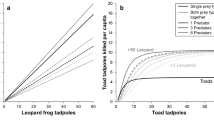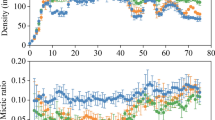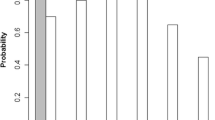Summary
-
1.
We examine the idea that predators may sometimes use a rule of thumb (in this case prey size) to estimate relative prey profitability for optimizing diet selection. We provided adult common shrews with a choice between large and small pieces of mealworm, where large pieces were less profitable than small, because of handling time characteristics.
-
2.
The tendency for animals to prefer large prey depended on their encounter rate with large prey, but was not influenced by variation in encounter rate with small prey once a threshold encounter rate with large (about 0.03 encounters/s) had been reached.
-
3.
We also tested the hypothesis that a predator would be less selective when competing with other animals for food. Shrews showed a significant reduction in selectivity when an apparent ‘competitor’ was present during a test.
Similar content being viewed by others
References
Barnard CJ (1978) Aspects of winter flocking and food fighting in the house sparrow (Passer domesticus L.) D Phil thesis, University of Oxford
Barnard CJ, Stephens H (1981) Prey size selection by lapwings in lapwing/gull associations. Behaviour (in press)
Charnov EL (1976) Optimal foraging: Attack strategy of a mantid. Am Nat 110:141–151
Churchfield JS (1979) Studies on the ecology and behaviour of British shrews. Ph D thesis, University of London
Crowcroft P (1955) The Life of the Shrew. Reinhardt, London
Davies NB (1977) Prey selection and the search strategy of the spotted flycather (Muscicapa striata), a field study on optimal foraging. Anim Behav 25:1016–1033
Erichsen JT, Krebs JR, Houston AI (1980) Optimal foraging and cryptic prey. J Anim Ecol 49:271–276
Fredericson E (1953) The wall-seeking tendency of three inbred mouse strains (Mus musculus). J Gen Psychol 82:143–146
Holling CS (1959) The components of predation, as revealed by a study of small mammal predation of the European pine sawfly. Can Entomol 91:293–332
Houston AI, Krebs JR, Erichsen JT (1980) Optimal prey choice and discrimination time in the great tit (Parus major L.). Behav Ecol Sociobiol 6:169–175
Krebs JR (1978) Optimal foraging: decision rules for predators. In: Krebs JR, Davies NB (eds) Behavioural ecology: An evolutionary approach. Blackwall, Oxford
Krebs JR, Erichsen JT, Webber MI, Charnov EL (1977) Optimal prey selection in the great tit, Parus major. Anim Behav 25:30–38
Pernetta JC (1974) Field and laboratory experiments to determine the ecology of Sorex araneus (Linnaeus 1758) and Sorex minutus (Linnaeus 1766). D Phil thesis, University of Oxford
Pyke GH, Pulliam HR, Charnov EL (1977) Optimal foraging: a selective review of theory and tests. Q Rev Biol 52:137–154
Schoener TW (1974) The niche compression hypothesis and temporal resource partitioning. Proc Natl Acad Sci USA 71:4169–4172
Southern HN, Corbet GB (eds) (1977) The handbook of British mammals. Blackwell, Oxford
Werner EE, Hall DJ (1974) Optimal foraging and the size selection of prey by the Bluegill Sun fish (Lepomis Macrochirus). Ecology 55:1216–1232
Author information
Authors and Affiliations
Rights and permissions
About this article
Cite this article
Barnard, C.J., Brown, C.A.J. Prey size selection and competition in the common shrew (Sorex araneus L.). Behav Ecol Sociobiol 8, 239–243 (1981). https://doi.org/10.1007/BF00299836
Received:
Accepted:
Issue Date:
DOI: https://doi.org/10.1007/BF00299836




